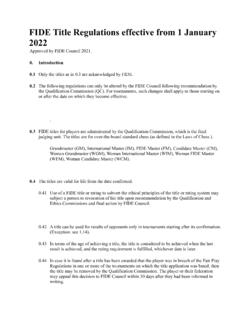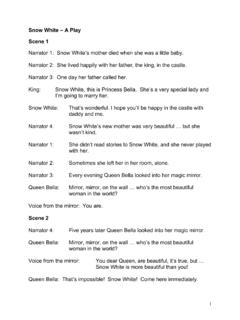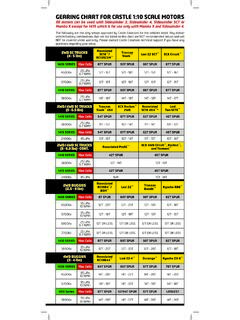Transcription of FIDE LAWS of CHESS
1 1 FIDE laws of CHESS Contents: PREFACE page 2 BASIC RULES OF PLAY Article 1: The nature and objectives of the game of CHESS page 2 Article 2: The initial position of the pieces on the chessboard page 3 Article 3: The moves of the pieces page 4 Article 4: The act of moving the pieces page 7 Article 5: The completion of the game page 8 COMPETITION RULES Article 6: The CHESS clock page 9 Article 7: Irregularities page 11 Article 8: The recording of the moves page 11 Article 9: The drawn game page 12 Article 10: Quickplay finish page 13 Article 11: Points page 14 Article 12: The conduct of the players page 14 Article 13: The role of the arbiter (see Preface) page 15 Article 14: FIDE page 16 Appendices: A.
2 Rapidplay page 17 B. Blitz page 17 C. Algebraic notation page 18 D. Quickplay finishes where no arbiter is present in the venue page 20 E. Rules for play with Blind and Visually Handicapped page 20 F. Chess960 rules page 22 Guidelines in case a game needs to be adjourned page 24 2 FIDE laws of CHESS cover over-the-board play. The English text is the authentic version of the laws of CHESS , which was adopted at the 79th FIDE Congress at Dresden (Germany), November 2008, coming into force on 1 July 2009. In these laws the words he , him and his include she and her . PREFACE The laws of CHESS cannot cover all possible situations that may arise during a game, nor can they regulate all administrative questions.
3 Where cases are not precisely regulated by an Article of the laws , it should be possible to reach a correct decision by studying analogous situations which are discussed in the laws . The laws assume that arbiters have the necessary competence, sound judgement and absolute objectivity. Too detailed a rule might deprive the arbiter of his freedom of judgement and thus prevent him from finding the solution to a problem dictated by fairness, logic and special factors. FIDE appeals to all CHESS players and federations to accept this view. A member federation is free to introduce more detailed rules provided they: a. do not conflict in any way with the official FIDE laws of CHESS , and b. are limited to the territory of the federation concerned, and c.
4 Are not valid for any FIDE match, championship or qualifying event, or for a FIDE title or rating tournament. BASIC RULES OF PLAY Article 1: The nature and objectives of the game of CHESS The game of CHESS is played between two opponents who move their pieces alternately on a square board called a chessboard . The player with the white pieces commences the game. A player is said to have the move , when his opponent s move has been made . (See Article ) The objective of each player is to place the opponent s king under attack in such a way that the opponent has no legal move. The player who achieves this goal is said to have checkmated the opponent s king and to have won the game.
5 Leaving one s own king under attack, exposing one s own king to attack and also capturing the opponent s king are not allowed. The opponent whose king has been checkmated has lost the game. If the position is such that neither player can possibly checkmate, the game is drawn. 3 Article 2: The initial position of the pieces on the chessboard The chessboard is composed of an 8 x 8 grid of 64 equal squares alternately light (the white squares) and dark (the black squares). The chessboard is placed between the players in such a way that the near corner square to the right of the player is white . At the beginning of the game one player has 16 light-coloured pieces (the white pieces); the other has 16 dark-coloured pieces (the black pieces).
6 These pieces are as follows: A white king usually indicated by the symbol A white queen usually indicated by the symbol Two white rooks usually indicated by the symbol Two white bishops usually indicated by the symbol Two white knights usually indicated by the symbol Eight white pawns usually indicated by the symbol A black king usually indicated by the symbol A black queen usually indicated by the symbol Two black rooks usually indicated by the symbol Two black bishops usually indicated by the symbol Two black knights usually indicated by the symbol Eight black pawns usually indicated by the symbol The initial position of the pieces on the chessboard is as follows: The eight vertical columns of squares are called files.
7 The eight horizontal rows of squares are called ranks . A straight line of squares of the same colour, running from one edge of the board to an adjacent edge, is called a diagonal . 4 Article 3: The moves of the pieces It is not permitted to move a piece to a square occupied by a piece of the same colour. If a piece moves to a square occupied by an opponent s piece the latter is captured and removed from the chessboard as part of the same move. A piece is said to attack an opponent s piece if the piece could make a capture on that square according to the Articles to A piece is considered to attack a square, even if such a piece is constrained from moving to that square because it would then leave or place the king of its own colour under attack.
8 The bishop may move to any square along a diagonal on which it stands. The rook may move to any square along the file or the rank on which it stands. The queen may move to any square along the file, the rank or a diagonal on which it stands. 5 When making these moves the bishop, rook or queen may not move over any intervening pieces. The knight may move to one of the squares nearest to that on which it stands but not on the same rank, file or diagonal. a. The pawn may move forward to the unoccupied square immediately in front of it on the same file, or b. on its first move the pawn may move as in or alternatively it may advance two squares along the same file provided both squares are unoccupied, or c.
9 The pawn may move to a square occupied by an opponent s piece, which is diagonally in front of it on an adjacent file, capturing that piece. d. A pawn attacking a square crossed by an opponent s pawn which has advanced two squares in one move from its original square may capture this opponent s pawn as though the latter had been moved only one square. This capture is only legal on the move following this advance and is called an en passant capture. 6 e. When a pawn reaches the rank furthest from its starting position it must be exchanged as part of the same move on the same square for a new queen, rook, bishop or knight of the same colour. The player s choice is not restricted to pieces that have been captured previously.
10 This exchange of a pawn for another piece is called promotion and the effect of the new piece is immediate. a. There are two different ways of moving the king: by moving to any adjoining square not attacked by one or more of the opponent s pieces or by castling . This is a move of the king and either rook of the same colour along the player s first rank, counting as a single move of the king and executed as follows: the king is transferred from its original square two squares towards the rook on its original square, then that rook is transferred to the square the king has just crossed. Before white kingside castling After white kingside castling Before black queenside castling After black queenside castling Before white queenside castling After white queenside castling Before black kingside castling After black kingside castling 7 b.










